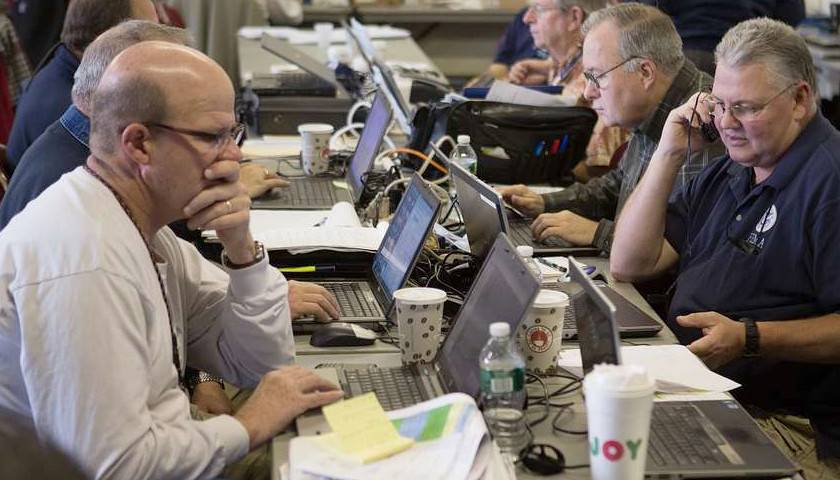Inflation rose slightly in October despite a massive slowdown in job growth in the same month, according to a Bureau of Labor Statistics (BLS) report released Wednesday.
Read MoreTag: Bureau of Labor Statistics
Lawmakers Want Answers After Revision to Job Numbers
Lawmakers are launching an inquiry into the Department of Labor’s Bureau of Labor Statistics after it significantly overestimated the number of jobs created last year, creating a far rosier picture of the U.S. economy than was actually the case.
The federal government announced earlier this year that its previous jobs data had far overestimated how many jobs the U.S. economy created last year. In fact, the federal data was revised down by a third, or roughly 800,000 jobs, the largest revision since 2009.
Read MoreGenerous Benefit Plans Leading Government Employees to Be Nearly 40 Percent More Expensive than Private Sector
State and local government workers were roughly 40% more expensive to employ than private sector employees in the second quarter of 2024, largely due to generous benefit plans, according to data from the Bureau of Labor Statistics (BLS) released Tuesday.
Total compensation costs, including wages, salaries and benefits, averaged $43.94 per hour for private sector employees, approximately 40% less than the $61.37 average hourly compensation cost for state and local government workers, according to the BLS data. The disparity was primarily driven by pricey government benefit plans, with costs averaging $13.04 per hour for private industry workers, over 80% less than the $23.57 per hour in benefit costs for their state and local government counterparts.
Read MoreInflation Rate Inches Down as Economy Continues to Slow
Inflation fell in August amid fears of an economic slowdown following two straight months of disappointing job gains, according to the latest Bureau of Labor Statistics (BLS) release on Wednesday.
The consumer price index (CPI), a broad measure of the price of everyday goods, increased 2.5% on an annual basis in August and rose 0.2% month-over-month, compared to a 2.9% year-over-year rate in July, according to the BLS. Core CPI, which excludes the volatile categories of energy and food, rose 3.2% year-over-year in August, compared with 3.2% in July.
Read MoreNationwide Education Effort Touts Increasing Public Union Opt-Outs
August ended on a high note for a free market conservative think tank that helps public employees opt out of their unions.
Read MoreOne in Three Jobs Biden Admin Announced over Course of a Year Didn’t Actually Exist, Revisions Show
Over a third of the more than 3 million jobs the Biden administration announced were added in initial reports between April 2023 and March 2024 did not actually exist, according to data from the Bureau of Labor Statistics (BLS).
Including monthly revisions, the Biden administration overstated the number of jobs in the U.S. economy by 1.18 million in the year through March, accounting for approximately 36% of the 3.24 million jobs initially claimed, according to data from the BLS calculated by the Daily Caller News Foundation. The massive revision, along with a disappointing July jobs report that showed the U.S. economy adding 61,000 fewer nonfarm payroll jobs than economists anticipated, has heightened fears of a recession.
Read MoreBiden Admin Overcounted Job Growth Estimates by Nearly a Million
The federal government overestimated the number of jobs in the U.S. economy by 818,000 between April 2023 and March 2024, according to data from the Bureau of Labor Statistics released Wednesday, stoking fears of a slowdown in the U.S. economy.
Economists at Goldman Sachs (GS) and Wells Fargo anticipated the government had overestimated job growth by at least 600,000 in that span, while economists at JPMorgan Chase had predicted a lesser decline of 360,000, according to Bloomberg. The downward revision follows a trend of the BLS overestimating the number of nonfarm payroll jobs added, with the cumulative number of new jobs reported in 2023 roughly 1.3 million less than previously thought as of February 2024.
Read MoreHousing Costs Surge in July, Accounting for 90 Percent of Total Inflation
The cost of housing surged in July, accounting for nearly 90 percent of total inflation, according to the latest Bureau of Labor Statistics Consumer Price Index (CPI) data released Wednesday.
Shelter costs rose 5.1 percent year-over-year and 0.4 percent month-over-month, after rising 0.2 percent in June, the BLS showed. The 0.4 percent monthly increase was greater than Bank of America economists’ expectations of 0.3 percent, according to investment research firm Morningstar.
Read MoreAnalysis: June Unemployment 352,000 Under Biden-Harris, 1.47 Million Unemployed Since 2023
The U.S. unemployment rate once again ticked up in the month of June to 4.3 percent as another 352,000 Americans said they were unemployed, according to the latest data from the Bureau of Labor Statistics. Markets are crashing in response.
Read MoreU.S. Job Growth Slows to a Crawl as Unemployment Rises
The U.S. added 114,000 nonfarm payroll jobs in July as the unemployment rate ticked up to 4.3%, according to Bureau of Labor Statistics (BLS) data released Friday.
Economists anticipated that the country would add 175,000 jobs in July compared to the 206,000 added in initial estimates for June, and that the unemployment rate would remain stable at 4.1%, according to U.S. News and World Report. Federal Reserve Chairman Jerome Powell noted in a press conference on Wednesday that a continued slowdown in the labor market could be a sign of further softening in the economy and contribute to a possible cut to the federal funds rate and an easing in harsh credit conditions that have weighed on Americans.
Read MoreNearly Four out of Five Americans Worry About Sky-High Home Energy Bills: Poll
More than 78 percent of U.S. adults say they are concerned about the energy bills, according to a recent CNET Money survey.
Read MoreInflation Falls Below Expectations as Economy Cools
Inflation ticked down slightly year-over-year in June as rising prices continue to weigh on average Americans’ finances, according to the latest Bureau of Labor Statistics (BLS) release on Wednesday.
The consumer price index (CPI), a broad measure of the price of everyday goods, increased 3.0 percent on an annual basis in June and decreased 0.1 percent month-over-month, compared to 3.3 percent in May, according to the BLS. Core CPI, which excludes the volatile categories of energy and food, remained high, rising 3.3 percent year-over-year in June, compared to 3.4 percent in May.
Read MoreUnemployment Rate Climbs for Another Month as Job Gains Slump
The U.S. added 206,000 nonfarm payroll jobs in June as the unemployment rate ticked up to 4.1%, according to Bureau of Labor Statistics (BLS) data released Friday.
Economists anticipated that 190,000 jobs would be added in June, far fewer than the initially reported 272,000 gain seen in May, and the unemployment rate would remain steady at 4%, according to U.S. News and World Report. Strong topline job gains in recent months have led some top economic officials, like Federal Reserve Chair Jerome Powell, to push back against claims that the economy is stalling, despite slow economic growth and high inflation.
Read MoreCommentary: Foreign-Born Workers are Taking Americans’ Jobs
Something very strange is going on in America’s labor market. The employer’s survey in the June jobs report showed 272,000 jobs gained in May, and nearly 2.8 million jobs over the past year. These are both amazing figures given that the economy is at full employment.
While the employer’s survey is surely fine, the household survey, also produced by the Bureau of Labor Statistics (BLS), tells a strikingly different story, almost as though the country had two different labor markets.
Read MoreFederal Reserve Keeps Key Interest Rate, Signaled Just One Cut Is Expected Before Year’s End
The Federal Reserve on Wednesday kept its key interest rate but signaled one cut is expected before the end of the year.
Read MoreFull-Time Jobs Vanish While Americans Race to Take Up Part-Time Work
Americans took up part-time jobs in huge numbers in May as full-time jobs evaporate under President Joe Biden’s economy, according to data from the Bureau of Labor Statistics (BLS) released Friday.
There were around 133.3 million people employed in the U.S. in May with full-time jobs, 625,000 less than the month before, while the number of people employed in part-time jobs surged by 286,000 to just over 28 million, according to the BLS. The total number of American workers collapsed by 408,000 as a result of the loss in part-time jobs to 161 million.
Read MoreUnemployment Ticks Up as Job Growth Beats Expectations
The U.S. added 272,000 nonfarm payroll jobs in May as the unemployment rate ticked up to 4.0%, according to the Bureau of Labor Statistics (BLS) data released Friday.
Economists anticipated that the country would add 190,000 jobs in May compared to the 175,000 jobs that were added in initial estimates for April and that the unemployment rate would remain unchanged at 3.9%, according to U.S. News and World Report. The job gains follow predictions that the economy is slowing down, with an early estimate for second-quarter gross domestic product (GDP) being revised down to 1.8% from 4.2% over the last month by the Federal Reserve Bank of Atlanta.
Read MoreAmericans are Getting Poorer While Prices Keep Going Up
Americans’ real weekly earnings dropped sharply in April and still remain well below their level when President Joe Biden first took office, according to data from the Bureau of Labor Statistics (BLS).
Real average weekly earnings fell to $1,191.93 in April, declining by 0.4% in the month and 4.8% compared to the start of Biden’s term in January 2021, according to data calculated by the Daily Caller News Foundation from the BLS. Prices have risen over 19% since Biden first took office and 3.4% in the last year, degrading the value of Americans’ wages.
Read MoreInflation Stays High as Rising Prices Continue to Squeeze Americans
Inflation ticked down slightly year-over-year in April but still remained high as rising prices continue to take a toll on average Americans’ finances, according to the latest Bureau of Labor Statistics (BLS) release on Tuesday.
The consumer price index (CPI), a broad measure of the prices of everyday goods, increased 3.4% on an annual basis in April and 0.3% month-over-month, compared to 3.5% in March, according to the BLS. Core CPI, which excludes the volatile categories of energy and food, remained higher, rising 3.6% year-over-year in April, compared to 3.8% in February.
Read MoreProducer Inflation Makes Biggest Jump in a Year in Potential Warning Sign for Future Economy
A measure of wholesale inflation that tracks prices before they reach consumers surged to its fastest annual rate since April 2023, according to new data released Tuesday by the Bureau of Labor Statistics (BLS).
The producer price index (PPI) rose 0.5 percent in April, totaling a 2.2 percent annual rate, far higher than estimates that the index would rise 0.3 percent in the month, according to the BLS. The report adds to fears that inflation is once again surging following the consumer price index jumping to 3.5 percent in March, up from 3.2 percent in February and far from the Federal Reserve’s 2 percent target.
Read MoreLatest Productivity Data Spells More Trouble for Future of American Economy
U.S. productivity growth slowed in the first quarter of 2024, casting doubt on the American economy’s future growth, according to data released by the Bureau of Labor Statistics (BLS) on Thursday.
Growth in U.S. business productivity slowed to just 0.3% in the first quarter of 2024, below economists’ predictions of 0.5% and far lower than the 3.5% rate of growth achieved in the fourth quarter of 2023, according to the BLS. Sluggish growth in productivity bodes poorly for broader gross domestic product (GDP) growth, which slowed to 1.6% in the first quarter of 2024.
Read MoreGains in Government Jobs Couldn’t Save Biden’s Economy in April
Growth in government jobs slowed in April, bucking the pattern that has contributed to above-trend job growth over the past several months, according to data from the Bureau of Labor Statistics (BLS).
Employment in government grew just 8,000 in April, lower than the average over the past year of 55,000 per month, according to data from the BLS. A slowdown in government hiring led total job growth in April to be largely anemic compared to recent months, with the U.S. adding only 175,000 nonfarm payroll positions in the month, lower than the average over the past year of 242,000.
Read MoreJob Market Continues Hot Streak Despite Persistent Layoffs
The U.S. added 303,000 nonfarm payroll jobs in March as the unemployment rate ticked down to 3.8%, according to Bureau of Labor Statistics (BLS) data released Friday.
Economists anticipated that the country would add 200,000 jobs in March compared to the 275,000 jobs that were added in initial estimates for February, and that the unemployment rate would remain unchanged at 3.9%, according to Reuters. The job gains are in spite of persistent layoffs that reached a 14-month peak in March at 90,309.
Read MoreLayoffs Surge to 14-Month High as Inflation Crushes Employers
The number of people laid off from American companies reached the highest point since January 2023, according to data from outplacement firm Challenger, Gray & Christmas, Inc.
American employers cut 90,309 employees in March, 7 percent higher than the 84,638 employees laid off in February and higher than the 82,307 positions cut in January, according to a report from Challenger, Gray & Christmas, Inc. The layoffs are in contrast to seemingly strong job gains, which totaled 275,000 in February, while the unemployment rate ticked up to 3.9 percent.
Read MoreGovernment Releases Another Batch of Data That Wipes Out Previous Economic Gains
New orders for manufactured durable goods, which serve as an indicator for longer-term investments from businesses and consumers, had a huge downward revision for January, following similar revisions seen in jobs data.
Orders for durable goods increased 1.4 percent in February to $277.9 billion, but January’s gains were revised down to -6.9 percent from an initial estimate of -6.1 percent, taking a huge chunk out of previously reported gains, according to data from the U.S. Census Bureau. The revisions for durable goods orders mirror revisions in employment figures, which have repeatedly reported high growth figures that are later revised down, most recently being revised down for January by 124,000 while job growth for February was reported as 275,000.
Read MoreGovernment Jobs Continue to Swell Under Biden as Unemployment Ticks Up
The U.S. set another new record for the total number of government jobs in February, even as overall unemployment ticks up, according to data from the Bureau of Labor Statistics (BLS).
The government added 52,000 positions in February, around the average gain per month seen in the last year, totaling 23,180,000, according to the BLS. The U.S. economy added 275,000 nonfarm payroll jobs in February, far higher than expectations of 200,000, but unemployment shot up from 3.7% to 3.9%.
Read MoreJob Gains Surge for Another Month as Unemployment Ticks Up
The U.S. added 275,000 nonfarm payroll jobs in February as the unemployment rate ticked up to 3.9%, according to Bureau of Labor Statistics (BLS) data released Friday.
Economists anticipated that the country would add 200,000 jobs in February compared to the 353,000 that were added in January, and that the unemployment rate would remain at 3.7%, according to Reuters. The job gains were announced two days after Jerome Powell, chair of the Federal Reserve, told the House Financial Services Committee in its semi-annual monetary policy report that he does not believe that there is evidence for a recession, meaning rate cuts could be on the horizon.
Read MoreGovernment Jobs Soared to New Record for Another Month as Federal Debt Piles Up
The U.S. set a new record in January for the total number of Americans employed by the government, according to data from the Bureau of Labor Statistics (BLS).
The government added 36,000 new employees in January, with 11,000 in the federal government and 19,000 in local government, totaling 23,091,000, according to the BLS. January’s total outdid the previous record of 23,055,000 that was set in December, marking the third month in a row with a new record.
Read MoreFull-Time Work Is Being Replaced by Part-Time Jobs as Americans and Businesses Struggle
Since June 2023, Americans have been increasingly employed in part-time positions, with a subsequent decline in full-time work, according to data from the Bureau of Labor Statistics (BLS).
The number of Americans working part-time in January grew by 96,000 compared to the previous month, while full-time employment sank by 63,000, according to the BLS. The change in the types of employment follows a trend toward part-time employment that has been increasingly exacerbated since June 2023.
Read MoreJob Growth Exceeds Expectations Despite Mass Layoffs
The U.S. added 353,000 nonfarm payroll jobs in January as the unemployment rate remained at 3.7%, according to Bureau of Labor Statistics (BLS) data released Friday.
Economists anticipated that the country would add 180,000 jobs in January compared to the 216,000 that were added in December and that the unemployment rate would tick up to 3.8% from 3.7%, according to Reuters. Despite the job gains, American employers cut 82,307 positions in January, a 136% jump from the previous month, amid a wider trend of layoffs as factors like high inflation continue to hurt business conditions.
Read MoreAlmost a Quarter of All Jobs Added in 2023 Didn’t Actually Exist
The original number of jobs reported by the federal government in 2023 was revised down by a total of 749,000 jobs, meaning nearly one-fourth of jobs thought to be created in the year were not actually there, according to data from the Bureau of Labor Statistics (BLS) analyzed by the Daily Caller News Foundation.
The sum of the initial estimate from each of the government’s monthly job growth reports in 2023 totaled 3,140,000 new jobs, with later reports revising down the number of jobs added by a collective 443,000, according to the BLS. The BLS also announced in August a revision in total employment for March, subtracting another 306,000 jobs.
Read MoreGovernment Employees Exceed 23 Million for the First Time
Government employees in the United States topped 23 million for the first time in December, according to the employment numbers released today by the Bureau of Labor Statistics.
In November, according to BLS, there were 22,951,000 people employed by the local, state and federal governments in the United States. In December, there were 23,003,000.
Read MoreCommentary: As Inflation Cools, Fed Keeps Rates Steady, Slowdown Expected in 2024
The Federal Reserve on Dec. 13 held the Federal Funds Rate—the rate at which banks lend to each other—steady at 5.25 percent to 5.5 percent, as the consumer inflation once again cooled to 12-month average level of 3.1 percent, according to the latest data compiled by the Bureau of Labor Statistics.
Leading the cooldown were drops in energy prices as gasoline dropped 6 percent in November, following a 5 percent drop in October.
Read MoreInflation Refuses to Go Away as Prices Stay Elevated
Inflation ticked slightly down year-over-year in November but continued to remain well above the Federal Reserve’s target, according to the latest Bureau of Labor Statistics (BLS) release on Tuesday.
The consumer price index (CPI), a broad measure of the prices of everyday goods, increased 3.1% on an annual basis in November, compared to 3.2% in October, according to the BLS. Core CPI, which excludes the volatile categories of energy and food, remained high, rising 4.0% year-over-year in October, compared to 4.0% in October.
Read MoreBiden Is Close to Setting a New Record — More Government Jobs than Ever Before
The total number of government employees in the U.S. is edging close to a new record, only being outdone by one other month in the country’s history, according to data from the Bureau of Labor Statistics (BLS).
The U.S. added 49,000 government jobs in November, with 32,000 of those being local and 17,000 of those being federal, bringing the total number of government employees to 22,967,000, according to the BLS. The number of total government employees in November is only outdone by one other month, with 22,996,000 people being employed by the government in May 2010 as a result of temporary hiring used to perform the census that year, according to the Federal Reserve Bank of St. Louis (FRED).
Read MoreJob Growth Remains Cool Despite Boost from Returning Strikers
The U.S. added 199,000 nonfarm payroll jobs in November as the unemployment rate ticked down to 3.7%, according to Bureau of Labor Statistics (BLS) data released Friday.
Economists had anticipated that the country would add 180,000 jobs in November compared to the 150,000 jobs that were added in October and that the unemployment rate would remain at 3.9%, according to Reuters. The number of jobs added in the month was boosted due to the resumption of work by autoworkers and actors who participated in the recent strikes.
Read MoreJob Gains Fall Short of Expectations as Unemployment Ticks Up
The U.S. added 150,000 nonfarm payroll jobs in October as the unemployment rate ticked up to 3.9%, according to Bureau of Labor Statistics (BLS) data released Friday.
Economists had anticipated that the country would add 180,000 jobs in October compared to the 336,000 jobs that were added in September and that the unemployment rate would remain at 3.8%, according to Reuters. On Wednesday, at the conclusion of its Federal Open Market Committee meeting, the Federal Reserve announced that it would be keeping its federal funds rate steady in the range of 5.25% and 5.50%, a 22-year high, after a series of 11 rate hikes that started in March 2022 in an effort to tame inflation.
Read MoreThe Biden Admin Has Overcounted New Jobs Almost Every Single Month This Year
The Biden administration has revised down previously reported jobs data for nearly every month this year, resulting in a huge disparity from the originally advertised numbers, according to the Bureau of Labor Statistics (BLS).
The number of jobs added in August was revised down from 227,000 to 165,000, and September was revised down from 336,000 to 297,000, resulting in 101,000 fewer jobs than were previously reported, according to the BLS. The U.S. economy added 150,000 jobs in October, subject to revisions in future reports, lower than the 170,000 jobs that economists expected.
Read MoreAmerica Adds over 300,000 Jobs in September as Interest Rates Remain Elevated
The U.S. added 336,000 nonfarm payroll jobs in September as the unemployment rate remained at 3.8%, according to Bureau of Labor Statistics (BLS) data released Friday.
Economists had anticipated that the country would add 170,000 jobs in September compared to 187,000 in August and that the unemployment rate would slide down to 3.7% from 3.8%, according to Reuters. Private employment data for September showed that only 89,000 jobs were added for the month, as the professional and business services, trade, transportations and utilities and manufacturing services sectors all had substantial losses, according to ADP.
Read MoreCommentary: Recession May Be Coming After 514,000 More Americans Struggle to Find Employment
The national unemployment rate reported by the Bureau of Labor Statistics jumped from 3.5 percent to 3.8 percent in August as an additional 514,000 Americans said they could not find work in the Bureau’s household survey. Now 6.3 million Americans are said to be unemployed, the highest in more than a year.
But it did not come with a commensurate drop in the number of Americans saying they were working, which also increased by 222,000 to 161.48 million.
Read MoreUnemployment Spikes as Job Market Continues to Cool
The U.S. added 187,000 nonfarm payroll jobs in August as the unemployment rate shot up to 3.8%, according to Bureau of Labor Statistics (BLS) data released Friday.
Economists had anticipated the country would add 170,000 jobs in August compared to 187,000 jobs in July, and that unemployment would remain unchanged at 3.5%, according to Reuters. The U.S. economy grew less than previously thought in the second quarter of 2023, with yearly real Gross Domestic Product being revised down from 2.4% to 2.1%.
Read MoreBiden’s Burdensome Regulations Are Contributing to Lackluster Economic Productivity, Experts Say
Labor productivity remains below COVID-19 pandemic levels after its first increase year-over-year was announced Thursday since 2021, with experts citing Biden administration regulations as one of the causes for the lackluster results.
Nonfarm business labor productivity reached 1.3% growth year-over-year for the second quarter of 2023 after declining for five straight quarters starting with the first quarter of 2022, according to the Bureau of Labor Statistics. The Biden administration has imposed a large amount of regulations that have hindered productivity, and the recent return to modest growth is in spite of these costly regulations , experts told the Daily Caller News Foundation.
Read MoreCommentary: Could the Baby Boomer Retirement Wave and Labor Shortages Absorb the Recession?
The national unemployment rate dipped to 3.5 percent in July, according to the latest data from the Bureau of Labor Statistics, once again hitting more than 50-year lows.
It’s still peak employment as far as the eye can see. Even with the past two years’ high inflation dropping dramatically and disinflation usually correlating with higher unemployment and a recession, that simply has not occurred yet, despite all the warning signs typically associated with an economic slowdown or downturn.
Read MoreJobs Market Cools Following Unexpectedly High Economic Growth
The U.S. added 187,000 jobs in July, less than economists expected, as the unemployment rate fell to 3.5%, according to Bureau of Labor Statistics (BLS) data released Friday.
Economists had anticipated the country would add 200,000 jobs in July compared to 209,000 jobs in June and that unemployment would remain the same at 3.6%, according to Reuters. The U.S. economy grew 2.4% for the year in the second quarter of 2023, outdoing expectations of 2%.
Read MoreCommentary: As Hiring Slows Down, So Does the Economy
The U.S. economy added 209,000 jobs in June, according to the latest establishment survey by the Bureau of Labor Statistics, less than expected as 306,000 were added in May, as hiring slowed down nationwide. Meanwhile, the unemployment rate remained about the same at 3.6 percent.
Historically, when hiring slows down by establishments, that usually coincides with economic slowdowns and recessions. In the recent cycle, the 2020 and 2021 recovery from Covid notwithstanding, hiring peaked at about 5.2 percent annualized increase in Feb. 2022. Now, it’s down to 2.5 percent.
Read MoreCommentary: Despite ‘Strong’ Rhetoric, Biden Administration Signals Gloomy Economic Outlook
The White House Office of Management and Budget (OMB) in the now-released President’s Budget is projecting just 0.6 percent in inflation-adjusted real growth of the U.S. economy in 2023 as the unemployment rate is expected to rise to 4.3 percent in 2023 and peak at 4.6 percent in 2024 after the economy is finished overheating from the continued, elevated inflation, consumers max out on credit and spending falls off a cliff.
Read MoreUnion Membership Plummets to Record Low Despite Biden’s Promises to Increase It
Rates of union membership fell to an all time low of 10.1% in 2022, according to a Thursday report from the Bureau of Labor Statistics (BLS), despite President Joe Biden’s promise to bolster American unions. Biden pledged to “be the most pro-union president you’ve ever seen” to a group of supporters the night before the 2020 election, according to the Associated Press, and signed an executive order in April 2021 creating a task force to investigate how the federal government could increase union membership. Despite these efforts, union membership continued its long decline in 2021 and 2022 as new non-union jobs outpaced union jobs, according to the BLS.
Read MoreThe Biden Admin Overestimated Recent Job Growth by over 10,000 Percent: Report
The Bureau of Labor Statistics overestimated the number of jobs added nationwide from March through June by roughly 10,600%, the Federal Reserve Bank of Philadelphia reported Tuesday.
The U.S. added just 10,500 net new jobs in the second quarter of 2022, a far cry from the 1,121,500 estimated by the Bureau of Labor Statistics’ (BLS) monthly report on state-level data known as the Current Employment Situation (CES), according to the Philadelphia Fed. By using more comprehensive data from the BLS Quarterly Census of Employment and Wages (QCEW), which samples roughly 11 million businesses compared to the 670,000 measured by the monthly CES, the Philadelphia Fed is able to make revisions to initial employment estimates, the regional bank reported.
Read MoreKey Inflation Metric Shows High Prices Aren’t Going Anywhere
Wholesale prices beat expectations in November, a sign that inflation might not fall as quickly or steeply as previously hoped, according to CNBC.
Producers and businesses saw prices rise 0.3% from October, with so-called “core prices” rising 0.4% when the more volatile food and energy sectors were discounted, according to the Bureau of Labor Statistics (BLS). With both measures expected to rise by just 0.2%, as well as a 3.3% increase in food costs offsetting a 3.3% decline in energy costs, producers prices are still set to remain well above pre-pandemic levels, even though they have fallen from the 11.7% year-over-year surge seen in March, CNBC reported.
Read MoreJob Growth Surpasses Expectations in November
The U.S. economy added 263,000 jobs in November, more than economists expected.
“Notable job gains occurred in leisure and hospitality, health care, and government,” the Bureau of Labor Statistics said. “Employment declined in retail trade and in transportation and warehousing.”
Read More

















































